10 SMS Customer Engagement Strategies to Boost Retention
.jpeg)
With so many channels competing for attention, it’s no surprise that your message might get lost along the way. Customers expect personal communication, but most businesses still rely on methods that are slow and impersonal.
Instead of hoping your emails get opened, you can send a short SMS that reaches your customer instantly and gets read within minutes. People treat texts as more personal, which helps you reach customers where they usually pay attention.
In this article, we’ll look at how SMS customer engagement works and learn strategies for stronger customer relationships.
You’ll also find out how the best SMS marketing platform can help you move beyond one-way marketing and start having real conversations that grow your business.
Why Do Customers Respond Better to Texts?
When it comes to customer communication, trust is everything, and SMS has become one of the most trusted channels around. Businesses use it not just to send updates but to create real-time engagement.
The difference in attention is evident. About 98% of text messages are opened, compared to around 20% for emails.
This makes SMS marketing one of the most reliable ways to boost engagement and strengthen customer relationships.
Customers also respond better to texts because they feel more in control. They know they’ve opted in, and they can easily reply or unsubscribe. This kind of relationship translates into stronger loyalty and better results for many businesses.
Using a unified platform for SMS management makes it easier to maintain this trust while managing messages at scale. You can schedule updates, send SMS offers, and keep a record of conversations without losing the personal touch.
When messages are timely, customers feel like they’re engaging with a brand that listens rather than one that only promotes. That’s the real strength of SMS customer engagement.
10 SMS Customer Engagement Strategies
The success of your SMS marketing strategy depends on more than just sending messages. Below are ten practical techniques you can use to make your text message marketing more powerful.
1. Build a Permission-Based Contact List
Before sending a single message, make sure customers have opted in. This keeps your brand compliant with texting regulations and helps increase customer engagement.
You can collect phone numbers through online forms, text-to-join campaigns, keyword QR codes, or in-store sign-ups. You may also offer a small incentive, such as a coupon or early access to promotions, to boost sign-ups and grow your SMS subscribers list.
Using an SMS customer engagement platform such as TextUs makes list management simple. It automatically records consent and allows easy SMS opt-out options.
This keeps your business compliant with privacy laws and helps maintain a list of active, engaged customers ready for future personalized communication.
Book a demo with TextUs today!
2. Segment Your Audience
Not all customers have the same interests or buying habits, so sending everyone the same message rarely works. You can segment customers in many ways, depending on your business type.
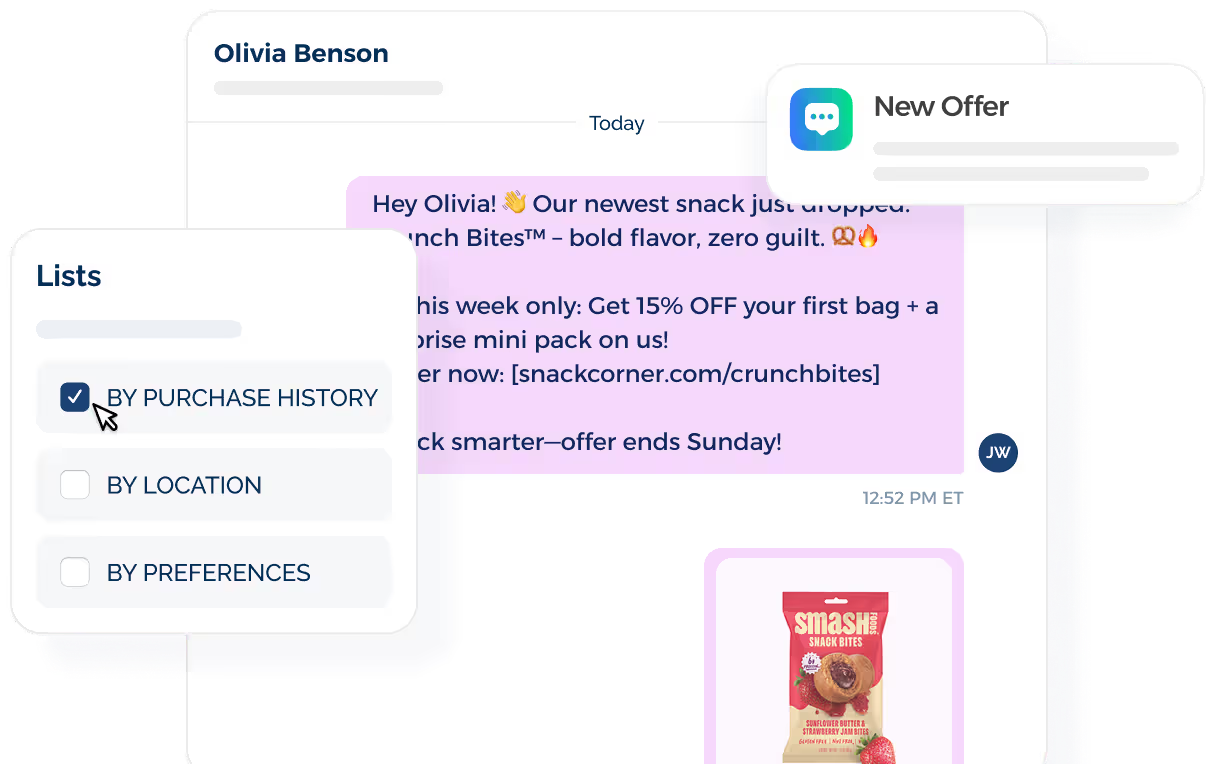
If you run an e-commerce store, you might group existing customers based on product preferences, purchase frequency, or spending range. A service-based business might separate new clients from long-term ones or send reminders only to those with upcoming appointments.
Segmenting your audience saves time and helps you improve customer engagement. You’ll notice fewer unsubscribes, more replies, and higher conversion rates as you deliver relevant messaging.
Mobile marketing solution like TextUs helps you handle SMS segmentation. You can create lists using filters, tags, or behavior-based triggers. The more you use data wisely, the better you can connect with each group and naturally enhance customer engagement.
3. Send Timely Updates
Timing your SMS campaigns plays a huge role in customer experience. You can have the most well-written message, but if it reaches customers at the wrong time, it loses its impact.
The goal is to send personalized SMS campaigns when they are most relevant, so your audience sees immediate value in opening them. Think about how your customers interact with your business throughout the day.
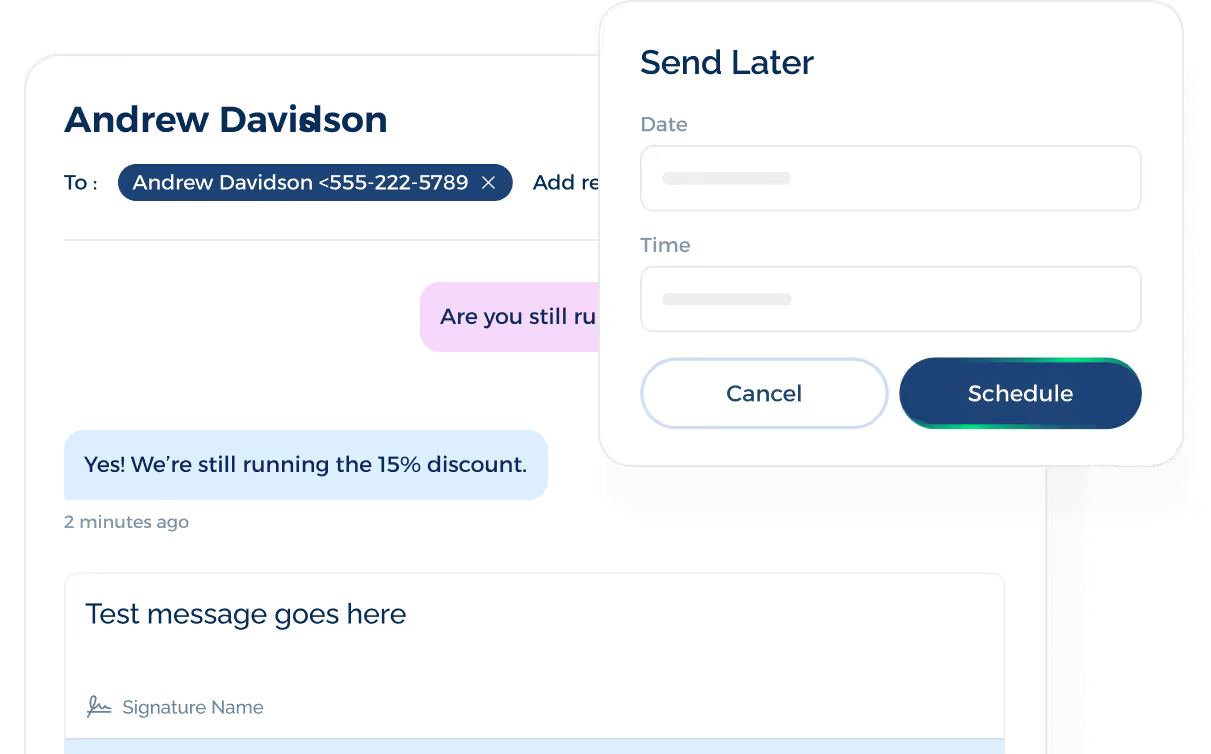
If you run an online store, it’s ideal to send weekend sale announcements on Friday afternoons when people are already planning their shopping. If you’re a service-based business, sending appointment reminders a day before the scheduled time can encourage customers to show up.
Scheduling your SMS marketing messages ahead of time helps you stay consistent without overwhelming your audience.
It also gives you space to plan seasonal or tailored campaigns, like “Back-to-School Deals” or “End-of-Month Renewal Reminders” that fit your overall marketing efforts.
4. Personalize Every Message
Personalized SMS marketing campaigns make your audience feel seen and valued. You can start by using a customer’s name in the message, but personalization goes deeper than that.
Think about customer behavior, location, or purchase history. For example, if someone recently bought a product, you can send a follow-up message asking how it worked out or offering a discount on a related item.
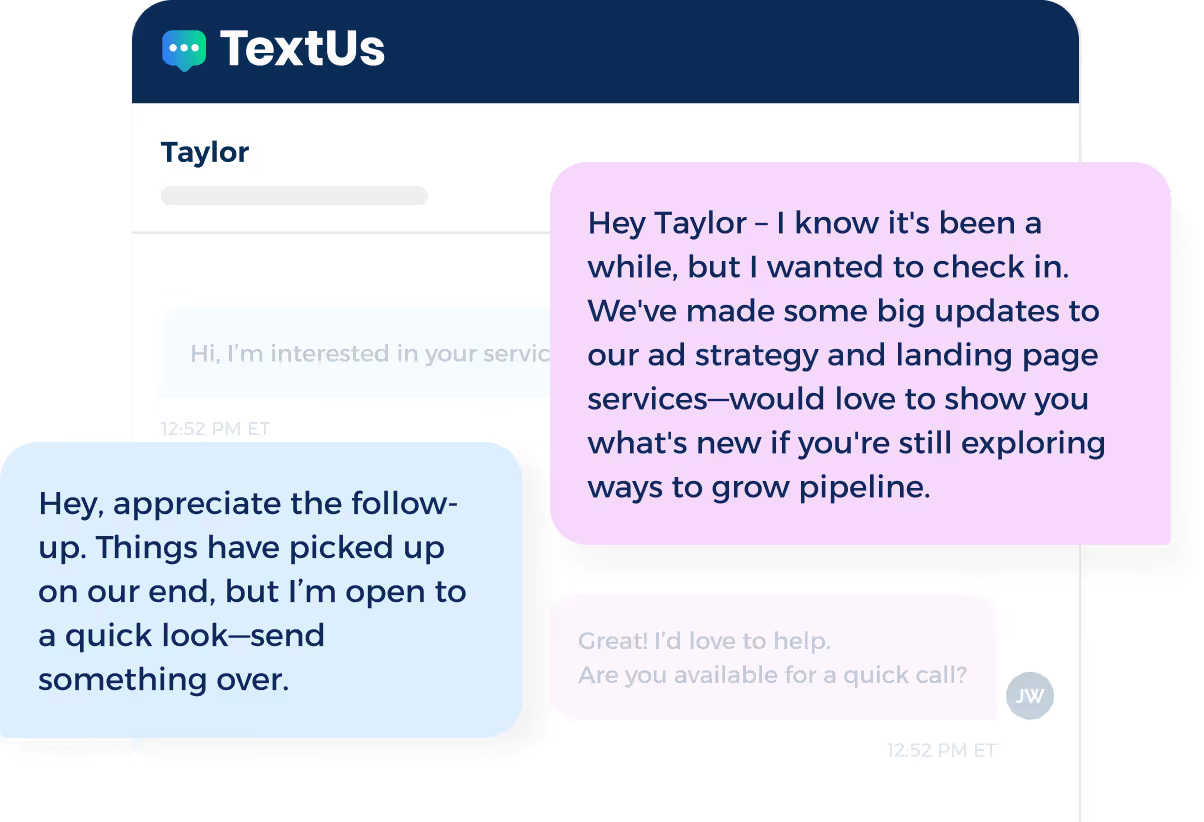
Personalization also helps build emotional connections that lead to long-term customer retention. A quick thank-you message after a purchase, or a friendly “Happy Birthday” text with a small offer, can go a long way.
These interactions don’t feel like marketing but rather feel like genuine relationship-building that strengthens your brand and increases customer lifetime value.
5. Keep Messages Short and Direct
In SMS customer engagement, your message doesn’t need to be long to make an impact. Long messages tend to be skimmed or skipped, while short ones get your attention right away.
While SMS isn’t limited to 160 characters anymore, the expectation remains the same. You need to keep your message actionable and relevant to drive customer engagement.
People read texts quickly, often while multitasking, so focus on delivering personalized value in as few words as possible.
For example, instead of writing, “We’re excited to announce that our new fall collection is now available, and we’d love for you to check it out on our website,” you can write, “Our fall collection is live! Tap here to shop: [link].” It’s shorter, easier to read, and more likely to get a response.
Also, avoid stuffing your texts with unnecessary details or multiple calls to action. You need to pick one purpose, like confirming an appointment or promoting a sale, and stick to it.
6. Use Two-Way Conversations
Texting shouldn’t just be about sending information. When customers can respond, ask questions, or provide feedback through text, it turns a simple message into a real conversation.
You can use two-way texting to handle support requests, schedule appointments, or gather quick opinions. This approach encourages authentic customer interactions and builds trust over time.
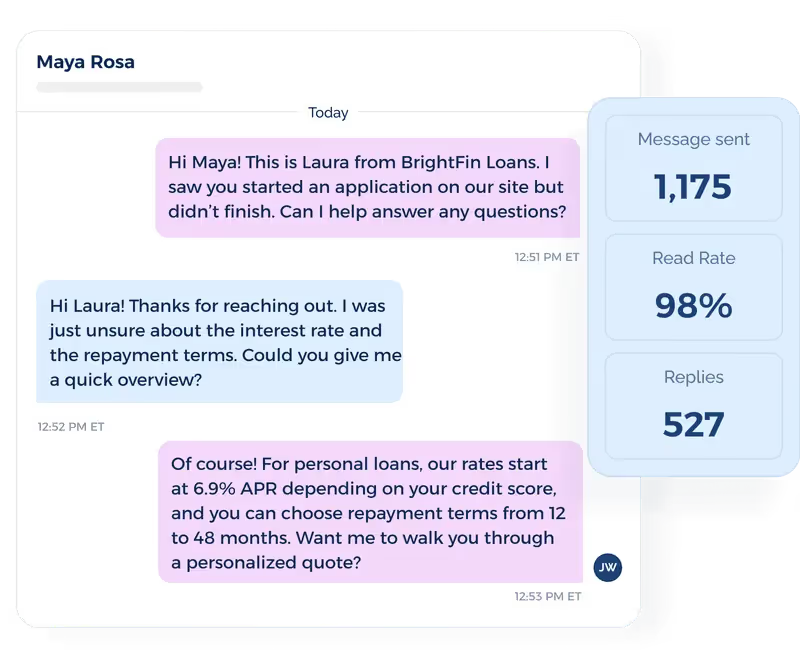
The advantage goes beyond convenience for businesses. Two-way texting offers you real-time insights into how customers feel about your services or products. If someone responds positively to a promotion or expresses frustration about an issue, you can act on it right away.
You can also use these replies to gauge customer satisfaction and improve future campaigns through data-driven personalization.
7. Automate Routine Messages
SMS marketing automation is one of the smartest ways to make customer engagement consistent and effortless for your business. You don’t need to send every reminder, confirmation, or thank-you message manually.
You can set automated texts for almost anything, such as appointment confirmations, order updates, payment reminders, and follow-up messages. You might send a shipped order notification automatically once the system detects a status change.
Automation also helps keep communication steady, even during busy periods when manual messaging isn’t practical. But to make automation work for you, you need to map out the moments in the customer journey where communication matters.
Think of the messages customers expect from you and set up automated workflows for those points. It keeps your brand responsive without constant hands-on effort. Small touches like using the customer’s first name or a friendly tone make a big difference.
8. Combine SMS With Other Channels
SMS works best when it’s part of a bigger system. When you coordinate your messages across multiple channels, you create a unified experience for your audience.
For example, if you’re running a new product launch, you can use email to share detailed information, social media to build excitement, and SMS to send quick reminders or limited-time offers.
Each channel plays its part. Your emails provide depth, your posts create buzz, and your texts drive action. This combination keeps your brand in front of your customers without overwhelming them on any single platform.
If you use texting as a follow-up tool, it can also increase response rates. Let’s say you send an email with a link to register for an event. A short text reminder a day later can nudge customers who didn’t open the email.
You can also direct customers from a text to your website, social page, or chat support when they need more information.
9. Send Surveys and Polls
Text messages are perfect for gathering honest customer feedback because they’re easy to respond to. Most people would rather tap out a reply on their phone than open a long text survey in an email.
You can use a customer survey to learn about customer satisfaction, product preferences, or recent experiences. For example, after a service appointment, you could send short questions to help you identify strengths and fix small problems before they become big ones.
Polls can also boost SMS customer engagement when used creatively. You might ask customers to vote on a new flavor, product design, or upcoming event idea. It’s a fun and interactive way to make them feel involved in your brand’s decisions.
These insights also help your sales team and marketing team refine their approach using real-time data gathered from your audience.
10. Reconnect With Inactive Customers
Every business has customers who stop responding or haven’t made a purchase in a while.
That’s where SMS customer engagement can help you bring them back through re-engagement efforts. Texting is a friendly way to reintroduce your brand without sounding pushy.
Start by identifying your inactive customers through predictive analytics and customer data. These tools help you spot trends and understand customer needs, which makes your SMS program strategic.
It could be people who haven’t opened your email marketing campaigns, visited your store, or made a purchase for several months. Then, send them a short, personalized message to remind them that you’re still around.
Sending a message like, “Hey, we noticed it’s been a while since your last visit. Is there anything we can do better?” opens the door for honest communication and gives you a chance to improve.
Types of Customer Engagement Strategies
Customer engagement strategies can take many forms depending on how you interact with your audience. Here are the main types of engagement strategies that work well across multiple touchpoints and industries.
Transactional Engagement
This is the most basic form of engagement. It happens when a customer interacts with your business for a specific reason, such as making a purchase or receiving an order confirmation.
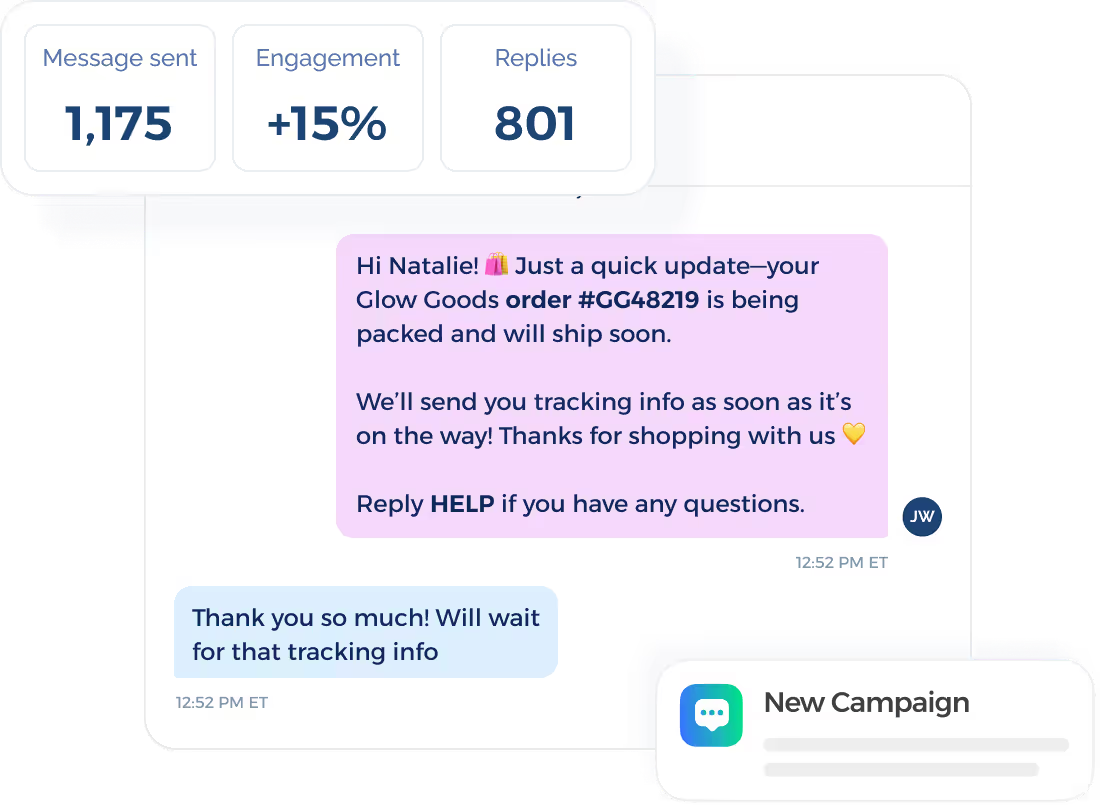
Though simple, it’s an important step in the relationship. SMS updates like payment confirmations or shipping alerts keep customers informed, improve customer engagement, and build confidence in your service.
Emotional Engagement
Emotional engagement focuses on creating a bond that goes beyond a product or service.
When a customer feels appreciated through thoughtful texts like thank-you messages or exclusive birthday offers, they’re more likely to stay loyal.
Texts make it easy to add a personal touch that builds this connection naturally through personalized experiences and personalized content.
Proactive Engagement
Instead of waiting for customers to reach out, you can contact them first with useful information. Examples include appointment reminders, service alerts, or helpful tips.
Proactive messages reduce missed opportunities and show customers that your business is attentive. They can also boost customer engagement by keeping your brand top of mind and creating opportunities for lead generation.
Conversational Engagement
Two-way texting allows customers to reply, ask questions, or request help in real time. It’s faster than email and more personal than chatbots. Using TextUs, you can handle these conversations easily, keeping a record of all replies and maintaining a consistent tone.
Behavioral Engagement
This strategy focuses on understanding how customers interact with your brand and responding based on their behavior. For example, if someone browses a product but doesn’t buy it, an automated text reminder can bring them back.
Using SMS marketing software lets you send SMS messages triggered by customer behavior, like abandoned cart notifications or product restock alerts.
Social Engagement
Customers spend a lot of time on social platforms, but SMS can be used to drive them there. You can send short links to contests, referral programs, or reviews to extend engagement beyond a single channel.
For example, an SMS message can invite customers to follow your brand on Instagram for a special reward, blending social and text-based engagement into one experience.
Go Beyond Campaigns and Create Conversations—Start Texting with TextUs!
If you’ve ever felt like your campaigns just aren’t reaching people the way they should, you need a smarter SMS solution.
TextUs brings together everything you need for customer engagement in one platform. You can schedule messages, automate follow-ups, and manage two-way conversations without losing the human touch.
Every text feels like it came from your brand, even when you’re messaging hundreds of people. TextUs helps drive incremental revenue by turning everyday messages into lasting customer relationships.
Customers are already reading and replying to texts faster than any other communication channel. It’s time for you to meet them where they’re most engaged.
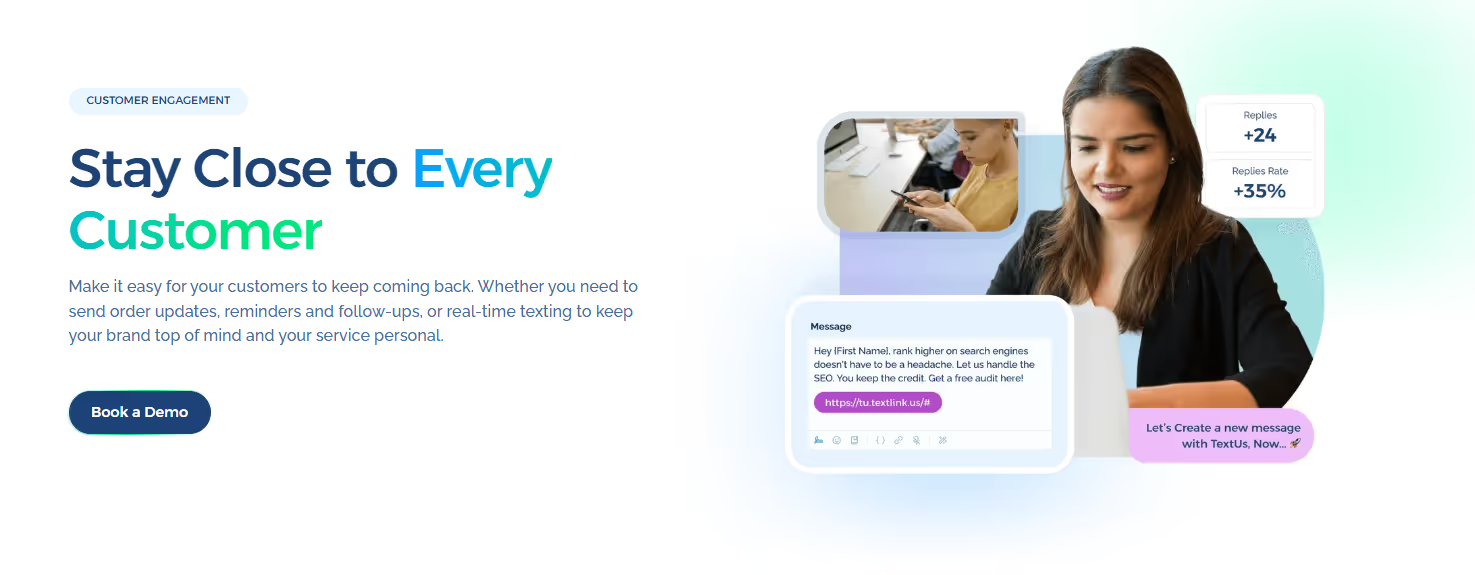
Book a demo with TextUs today and see how powerful authentic communication can be for your business!
FAQs About SMS Customer Engagement
What are the 4 P's of customer engagement?
The 4 P’s of customer engagement are Personalization, Proactivity, Persistence, and Performance.
- Personalization makes every interaction feel specific to each customer
- Proactivity is about reaching out before customers have to ask, like sending time-sensitive messages or helpful tips
- Persistence involves staying consistent with communication without being overbearing
- Performance refers to tracking your results and improving based on data
When you apply these four principles to SMS customer engagement, your targeted messages feel more thoughtful, your timing improves, and your results become easier to measure.
Is the SMS open rate 98%?
Yes, studies consistently show that SMS messages have open rates close to 98%, far higher than email or other digital channels. Most texts are read within three minutes of being received.
However, the quality of your engagement still depends on the message itself, such as timing, tone, and relevance, which matter just as much as reach.
Is SMS marketing legal in the USA?
Yes, SMS marketing is legal in the USA, but it comes with strict rules to protect consumers. The Telephone Consumer Protection Act (TCPA) requires you to get clear, written consent before sending promotional texts.
You must also give customers an easy way to opt out, such as replying “STOP.” Following these rules keeps your business compliant and builds trust with your audience.
What is replacing SMS?
Nothing is replacing SMS because it's evolving. While messaging apps like WhatsApp, Facebook Messenger, and RCS (Rich Communication Services) are growing in popularity, SMS remains the most universal and reliable option.
SMS also doesn’t depend on internet access or app downloads, which makes it accessible to everyone. In fact, many modern SMS marketing platforms now combine traditional texting with chat features, automation, and seamless integrations to keep up with customer expectations.
.avif)
Continue Reading
Frequently Asked Questions
Business Texting
Built for Results
Create and convert pipeline at scale through industry leading SMS software




